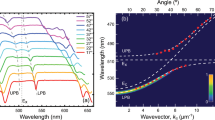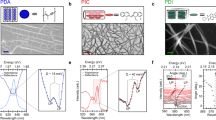Abstract
Under the right conditions, cavity polaritons form a macroscopic condensate in the ground state. The fascinating nonlinear behaviour of this condensate is largely dictated by the strength of polariton–polariton interactions. In inorganic semiconductors, these result principally from the Coulomb interaction between Wannier–Mott excitons. Such interactions are considerably weaker for the tightly bound Frenkel excitons characteristic of organic semiconductors and were notably absent in the first reported demonstration of organic polariton lasing. In this work, we demonstrate the realization of an organic polariton condensate, at room temperature, in a microcavity containing a thin film of 2,7-bis[9,9-di(4-methylphenyl)-fluoren-2-yl]-9,9-di(4-methylphenyl)fluorene. On reaching threshold, we observe the spontaneous formation of a linearly polarized condensate, which exhibits a superlinear power dependence, long-range order and a power-dependent blueshift: a clear signature of Frenkel polariton interactions.
This is a preview of subscription content, access via your institution
Access options
Subscribe to this journal
Receive 12 print issues and online access
$259.00 per year
only $21.58 per issue
Buy this article
- Purchase on Springer Link
- Instant access to full article PDF
Prices may be subject to local taxes which are calculated during checkout






Similar content being viewed by others
References
Carusotto, I. & Ciuti, C. Quantum fluids of light. Rev. Mod. Phys. 85, 299–366 (2013).
Kavokin, A. Microcavities (Oxford Univ. Press, (2007).
Savona, V., Tassone, F., Piermarocchi, C., Quattropani, A. & Schwendimann, P. Theory of polariton photoluminescence in arbitrary semiconductor microcavity structures. Phys. Rev. B 53, 13051–13062 (1996).
Tassone, F. & Yamamoto, Y. Exciton–exciton scattering dynamics in a semiconductor microcavity and stimulated scattering into polaritons. Phys. Rev. B 59, 10830–10842 (1999).
Christmann, G. et al. Polariton ring condensates and sunflower ripples in an expanding quantum liquid. Phys. Rev. B 85, 235303 (2012).
Sanvitto, D. et al. All-optical control of the quantum flow of a polariton condensate. Nature Photon. 5, 610–614 (2011).
Roumpos, G. et al. Single vortex-antivortex pair in an exciton-polariton condensate. Nature Phys. 7, 129–133 (2011).
Amo, A. et al. Polariton superfluids reveal quantum hydrodynamic solitons. Science 332, 1167–1170 (2011).
Amo, A. et al. Superfluidity of polaritons in semiconductor microcavities. Nature Phys. 5, 805–810 (2009).
Lagoudakis, K. G. et al. Quantized vortices in an exciton-polariton condensate. Nature Phys. 4, 706–710 (2008).
Carusotto, I. & Ciuti, C. Probing microcavity polariton superfluidity through resonant Rayleigh scattering. Phys. Rev. Lett. 93, 166401 (2004).
Dang, L.S., Heger, D., André, R., Boeuf, F. & Romestain, R. Stimulation of polariton photoluminescence in semiconductor microcavity. Phys. Rev. Lett. 81, 3920–3923 (1998).
Deng, H., Weihs, G., Snoke, D., Bloch, J. & Yamamoto, Y. Polariton lasing vs. photon lasing in a semiconductor microcavity. Proc. Natl Acad. Sci. USA 100, 15318–15323 (2003).
Imamoglu, A., Ram, R. J., Pau, S. & Yamamoto, Y. Nonequilibrium condensates and lasers without inversion: Exciton-polariton lasers. Phys. Rev. A 53, 4250–4253 (1996).
Deng, H., Haug, H. & Yamamoto, Y. Exciton-polariton Bose–Einstein condensation. Rev. Mod. Phys. 82, 1489–1537 (2010).
Wouters, M. & Carusotto, I. Excitations in a nonequilibrium Bose–Einstein condensate of exciton polaritons. Phys. Rev. Lett. 99, 140402 (2007).
Lu, T-C. et al. Room temperature polariton lasing vs. photon lasing in a ZnO-based hybrid microcavity. Opt. Express 20, 5530–5537 (2012).
Li, F. et al. From excitonic to photonic polariton condensate in a ZnO-based microcavity. Phys. Rev. Lett. 110, 196406 (2013).
Daskalakis, K. S. et al. All-dielectric GaN microcavity: Strong coupling and lasing at room temperature. Appl. Phys. Lett. 102, 101113–101113 (2013).
Christopoulos, S. et al. Room-temperature polariton lasing in semiconductor microcavities. Phys. Rev. Lett. 98, 126405 (2007).
Lidzey, D. G. et al. Strong exciton–photon coupling in an organic semiconductor microcavity. Nature 395, 53–55 (1998).
Kéna-Cohen, S., Davanço, M. & Forrest, S. R. Strong exciton–photon coupling in an organic single crystal microcavity. Phys. Rev. Lett. 101, 116401 (2008).
Kéna-Cohen, S. & Forrest, S. R. Room-temperature polariton lasing in an organic single-crystal microcavity. Nature Photon. 4, 371–375 (2010).
Ciuti, C., Savona, V., Piermarocchi, C., Quattropani, A. & Schwendimann, P. Role of the exchange of carriers in elastic exciton–exciton scattering in quantum wells. Phys. Rev. B 58, 7926–7933 (1998).
Mazza, L., Kéna-Cohen, S., Michetti, P. & La Rocca, G. C. Microscopic theory of polariton lasing via vibronically assisted scattering. Phys. Rev. B 88, 075321 (2013).
Mazza, L., Fontanesi, L. & La Rocca, G. C. Organic-based microcavities with vibronic progressions: Photoluminescence. Phys. Rev. B 80, 235314 (2009).
Slootsky, M., Zhang, Y. & Forrest, S. R. Temperature dependence of polariton lasing in a crystalline anthracene microcavity. Phys. Rev. B 86, 045312 (2012).
Utsunomiya, S. et al. Observation of Bogoliubov excitations in exciton-polariton condensates. Nature Phys. 4, 700–705 (2008).
Litinskaya, M. Exciton polariton kinematic interaction in crystalline organic microcavities. Phys. Rev. B 77, 155325 (2008).
Bittner, E. R. & Silva, C. Estimating the conditions for polariton condensation in organic thin-film microcavities. J. Chem. Phys. 136, 034510 (2012).
Zoubi, H. & La Rocca, G. C. Exciton–polariton kinematic interactions in organic microcavities. Phys. Rev. B 72, 125306 (2005).
Agranovich, V. M., Litinskaia, M. & Lidzey, D. G. Cavity polaritons in microcavities containing disordered organic semiconductors. Phys. Rev. B 67, 085311 (2003).
Michetti, P. & La Rocca, G. C. Polariton states in disordered organic microcavities. Phys. Rev. B 71, 115320 (2005).
Wouters, M., Liew, T. C. H. & Savona, V. Energy relaxation in one-dimensional polariton condensates. Phys. Rev. B 82, 245315 (2010).
Kéna-Cohen, S., Maier, S. A. & Bradley, D. D. C. Ultrastrongly coupled exciton–polaritons in metal-clad organic semiconductor microcavities. Adv. Opt. Mater. 1, 827–833 (2013).
Lin, H-W. et al. Anisotropic optical properties and molecular orientation in vacuum-deposited ter(9,9-diarylfluorene)s thin films using spectroscopic ellipsometry. J. Appl. Phys. 95, 881–886 (2004).
Kasprzak, J. et al. Bose–Einstein condensation of exciton polaritons. Nature 443, 409–414 (2006).
Porras, D & Tejedor, C. Linewidth of a polariton laser: Theoretical analysis of self-interaction effects. Phys. Rev. B 67, 161310 (2003).
Litinskaya, M., Reineker, P. & Agranovich, V. M. Fast polariton relaxation in strongly coupled organic microcavities. J. Lumin. 110, 364–372 (2004).
Toffanin, S. et al. Molecular host–guest energy-transfer system with an ultralow amplified spontaneous emission threshold employing an ambipolar semiconducting host matrix. J. Phys. Chem. B 114, 120–127 (2009).
Deng, H., Solomon, G. S., Hey, R., Ploog, K. H. & Yamamoto, Y. Spatial coherence of a polariton condensate. Phys. Rev. Lett. 99, 126403 (2007).
Wouters, M., Carusotto, I. & Ciuti, C. Spatial and spectral shape of inhomogeneous nonequilibrium exciton-polariton condensates. Phys. Rev. B 77, 115340 (2008).
Snoke, D. Exciton Polaritons in Microcavities 307–327 (Springer, (2012).
Wu, C. C., Lin, Y. T., Wong, K. T., Chen, R. T. & Chien, Y. Y. Efficient organic blue-light-emitting devices with double confinement on terfluorenes with ambipolar carrier transport properties. Adv. Mater. 16, 61–65 (2004).
Panzarini, G. et al. Cavity-polariton dispersion and polarization splitting in single and coupled semiconductor microcavities. Phys. Solid State 41, 1223–1238 (1999).
Acknowledgements
S.K-C. and S.A.M. acknowledge financial support from the UK Engineering and Physical Sciences Research Council through the Active Plasmonics programme grant (EP/H000917/1). K.S.D. and R.M. acknowledge support from the European ITN project Icarus (237900). S.A.M. and K.S.D. gratefully acknowledge partial support from a Leverhulme Trust Embedding of Emerging Disciplines grant. The authors would like to thank L. Mazza for a critical reading of the manuscript and I. Carusotto for helpful comments regarding ref. 16. S.K-C. thanks Imperial College London for the award of a Junior Research Fellowship.
Author information
Authors and Affiliations
Contributions
K.S.D. fabricated and characterized the TDAF microcavities. S.K-C. conceived the project, designed the structures and guided the experiments. K.S.D. and S.K-C. co-wrote the manuscript, and S.A.M. and R.M. contributed to the draft. All authors contributed to analysis of the data.
Corresponding author
Ethics declarations
Competing interests
The authors declare no competing financial interests.
Supplementary information
Supplementary Information
Supplementary Information (PDF 1159 kb)
Rights and permissions
About this article
Cite this article
Daskalakis, K., Maier, S., Murray, R. et al. Nonlinear interactions in an organic polariton condensate. Nature Mater 13, 271–278 (2014). https://doi.org/10.1038/nmat3874
Received:
Accepted:
Published:
Issue Date:
DOI: https://doi.org/10.1038/nmat3874
This article is cited by
-
Highly efficient polaritonic light-emitting diodes with angle-independent narrowband emission
Nature Photonics (2023)
-
Polarization superposition of room-temperature polariton condensation
Communications Materials (2023)
-
Exciton polariton interactions in Van der Waals superlattices at room temperature
Nature Communications (2023)
-
Manipulating nonlinear exciton polaritons in an atomically-thin semiconductor with artificial potential landscapes
Light: Science & Applications (2023)
-
Halide perovskites enable polaritonic XY spin Hamiltonian at room temperature
Nature Materials (2022)



